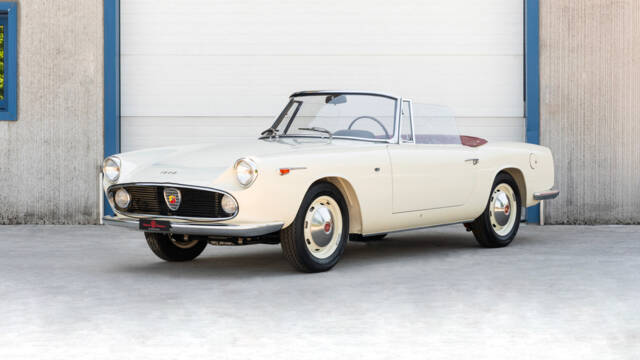Abarth 1600 classic cars for sale
The Abarth 1600 is a rare masterpiece from the golden age of Italian motorsport, renowned for its racing pedigree and technical innovation. This model stands out with its distinctive engineering approach and evocative design, setting benchmarks in performance and exclusivity. Discover why the Abarth 1600 holds a special place among classic enthusiasts.
Search results

1959 | Abarth 1600 Spider Allemano
Nut and Bolt Restored
History of the Abarth 1600
The Abarth 1600 emerged during a period when Carlo Abarth’s workshops were at the forefront of racing technology in Italy. Developed to compete in the highly competitive sports car categories of the 1960s, the 1600 was shaped by the spirit of motorsport and the relentless pursuit of improved performance. Utilising Fiat bases and often benefitting from Abarth’s expertise in lightweight construction and advanced tuning, the Abarth 1600 became synonymous with agility and speed on both road and track. The marque’s partnership with Fiat was instrumental to its engineering successes, and the 1600 encapsulates this era's relentless innovation.
The Evolution of the Abarth 1600 Model Range
The 1600 denotes a collection of race-oriented sports models by Abarth, usually powered by engines around 1.6 litres. While predecessors like the Abarth 1000 and 1300 established the company’s reputation in lower-capacity action, the 1600 marked a transition into larger displacement territory. Its successors would further evolve the formula, but the 1600 captured a unique phase where lightweight philosophy met increased power, bridging classic and modern engineering influences.
Highlights and Special Features
The Abarth 1600 is renowned for its advanced chassis tuning, light alloy construction, and meticulous attention to detail typical of boutique Italian manufacturers. The car's impressive road handling, bespoke racing components and limited production numbers contribute to its desirability. Unlike most other period sports cars, the 1600’s powertrain tuning and lightweight design enabled it to outperform larger rivals in agility and cornering.
Technical Data
Special Editions and Collectible Models
Due to Abarth’s focus on motorsport, most 1600s were produced in small numbers, often as homologation specials for specific racing events. Special bodied variants, sometimes crafted by renowned Italian carrozzeria, may have unique aesthetic and mechanical features distinguishing them from standard models.
Weak Spots and Common Issues
As with many hand-crafted, race-derived cars, the Abarth 1600 can exhibit age-related issues such as corrosion, particularly around aluminium panels and steel chassis joints. Parts supply for specialist mechanical components may require sourcing from marque specialists. Precise carburettor and ignition setup is crucial for reliable performance, and original documentation is an asset for authenticity verification.
Engine, Performance, Transmission and Handling
The heart of the Abarth 1600 is its free-revving four-cylinder engine, known for its energetic character and willingness to perform at high RPMs. The combination of a lightweight chassis and finely-tuned suspension yields precise, communicative handling—traits favoured by drivers with racing aspirations. Period road tests praised rapid acceleration, responsive gear changes and tenacious cornering ability. - Abarth 1600 Sport: Features the full racing chassis with distinct aerodynamic bodywork.
- Variants with Zagato or other bespoke bodywork: Notable for reduced weight and unique, hand-shaped aluminium panels.
Interior, Comfort, Exterior and Design
Typical for Abarth, the 1600’s cockpit was driver-focused, often fitted with minimalistic but high-quality bucket seats, concise instrumentation, and competition-grade steering wheels. Special attention was paid to the placement of controls to ensure optimal ergonomics for spirited driving. Exteriors could exhibit distinctive features from carrozzeria partnerships, such as uniquely contoured aluminium bodies painted in period racing colours. Accessories like additional rally gauges, harnesses, and lightweight magnesium wheels were available for motorsport customers.
Other Noteworthy Features
Owners often cite the direct lineage of the Abarth 1600 to successful racing entries in both hill climbs and endurance competitions. Special regulatory adaptations (such as FIA homologation requirements) sometimes mean that individual examples can possess custom engineering quirks or period modifications.
Summary
Every Abarth 1600 is a meticulously crafted testament to Italian motorsport’s heyday, equipped with innovative engineering and an engaging driving experience. With its strong presence in both supply and demand within the classic car market, the 1600 stands out not only for its technical merit but also as a symbol of 1960s racing prowess.
